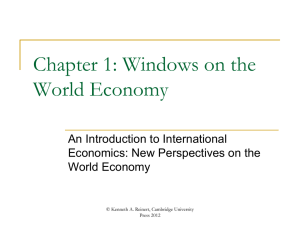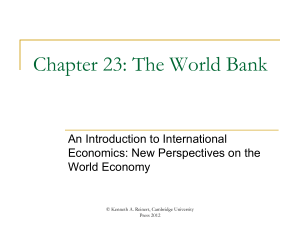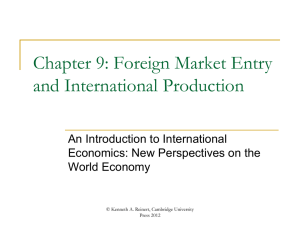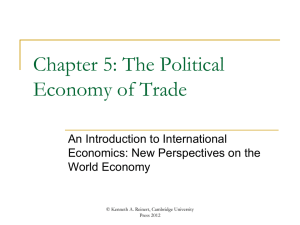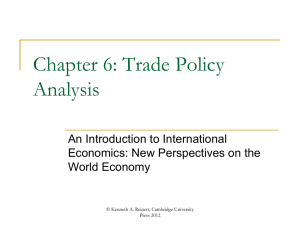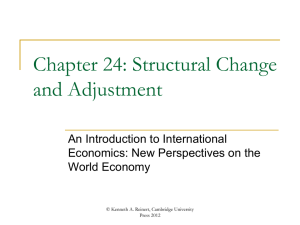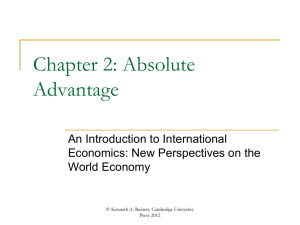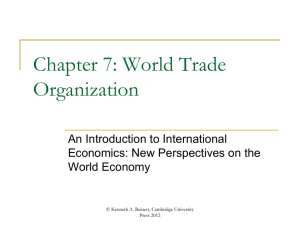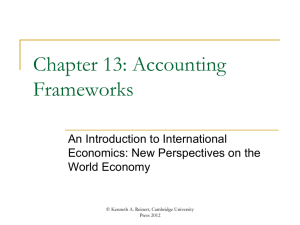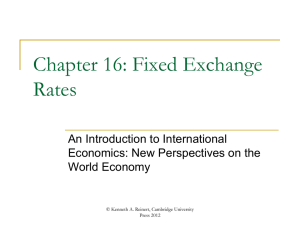Chapter 8 - An Introduction to International Economics
advertisement
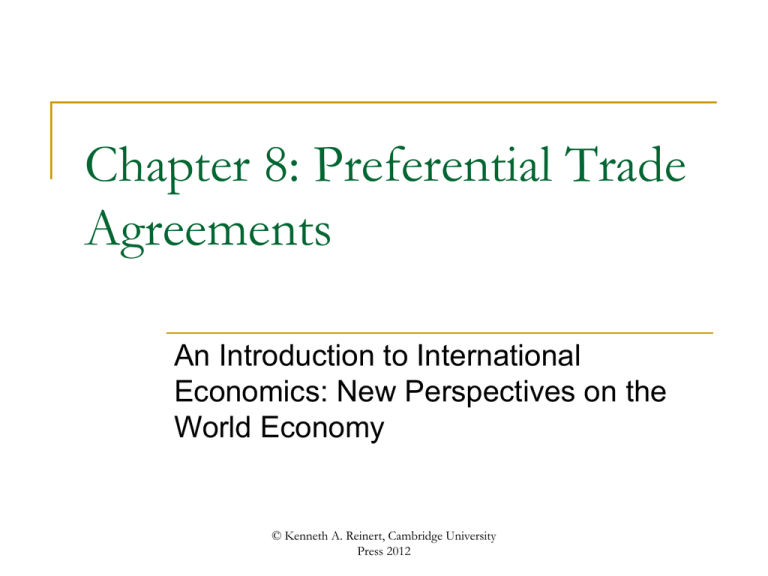
Chapter 8: Preferential Trade Agreements An Introduction to International Economics: New Perspectives on the World Economy © Kenneth A. Reinert, Cambridge University Press 2012 Analytical Elements Countries Sectors Tasks © Kenneth A. Reinert, Cambridge University Press 2012 Introduction The term multilateralism refers to the GATT/WTO system and the trade negotiations that take place within it One of the founding principles of this system is nondiscrimination Involves the most favored nation (MFN) and national treatment (NT) subprinciples “Regionalism” refers to a violation of the nondiscrimination principle in which one member of a regional trade agreement (RTA) discriminates in its trade policies in favor of another member of the RTA and against nonmembers Has been allowed by the GATT/WTO under certain circumstances: Free trade areas (FTAs) Customs unions (CUs) Interim agreements leading to a FTA or CU “within a reasonable length of time” © Kenneth A. Reinert, Cambridge University Press 2012 Table 8.1: Types of Preferential Trade Agreements Type of PTA Description Number in Force 2014 GATT Article XXIV (FTA) An agreement on the part of a set of countries to eliminate trade restrictions among themselves. 221 GATT Article XXIV (CU) An agreement on the part of a set of countries to eliminate trade restrictions among themselves and to adopt a common external tariff. 17 Enabling Clause Allows PTAs in goods trade among developing countries. 37 GATS Article V An agreement to reduce barriers to trade in services among a set of counties. 131 Total: 406 © Kenneth A. Reinert, Cambridge University Press 2012 Table 8.2: Steps to Regional Integration Type Description Free trade area An agreement on the part of a set of countries to eliminate trade restrictions among themselves. Customs union An agreement on the part of a set of countries to eliminate trade restrictions among themselves and to adopt a common external tariff. Common market An agreement on the part of a set of countries to eliminate trade restrictions among themselves, to adopt a common external tariff, and to allow the free movement of labor and physical capital among member countries. Monetary union A common market that adopts a common currency and adopts a common monetary policy. Economic union A monetary union that adopts a process of domestic policy harmonization in areas such as tax and spending policies and domestic regulation. © Kenneth A. Reinert, Cambridge University Press 2012 The WTO and PTAs WTO members who wish to form FTAs or CUs may do so However, there are certain requirements Trade barriers against non-members cannot be “higher or more restrictive than” those in existence prior to the FTA or CU FTA or CU must be formed “within a reasonable length of time” FTA or CU must eliminate trade barriers on “substantially all the trade” among the members With regard to services, the General Agreement on Trade in Services (GATS) requires that the FTA or CU involve “substantial sectoral coverage” © Kenneth A. Reinert, Cambridge University Press 2012 The WTO and PTAs: Enforcement The WTO has a Committee on Regional Trade Agreements (CRTA) Despite the institutional structure present in the WTO to govern PTAs, there has never been any serious evaluation or enforcement Most PTAs are of dubious WTO consistency A “cooperative equilibrium” exists where no WTO member contests another’s PTA © Kenneth A. Reinert, Cambridge University Press 2012 Rules of Origin In FTAs (but not CUs), a product can be imported into a low-tariff member and then resold in a high-tariff member This is known as tariff rate arbitrage Rules of origin (ROOs) protect against this Domestic content Change in tariff heading Specific processes Substantial transformation © Kenneth A. Reinert, Cambridge University Press 2012 Economic Effects of PTAs Trade creation Occurs when the formation of a FTA or CU leads to a switching of imports from a high-cost source to a low-cost source Tends to improve welfare Trade diversion Occurs when imports switch from a low-cost source to a high-cost source Tends to worsen welfare © Kenneth A. Reinert, Cambridge University Press 2012 Trade Creation and Trade Diversion Trade creation and trade diversion using the absolute advantage model of Chapter 2 Along with Brazil (B) and Argentina (A), we are also going to refer to a third country, El Salvador (S) Brazil and Argentina are members of a PTA, whereas El Salvador is not © Kenneth A. Reinert, Cambridge University Press 2012 Figure 8.1: Trade-Creating PTA © Kenneth A. Reinert, Cambridge University Press 2012 Trade Creation Before the PTA, Brazil has in place a specific (per unit) tariff on imports from both Argentina and El Salvador Argentina is the lower-cost producer in comparison to Venezuela Once Brazil joins either a PTA with Argentina, tariff is removed on imports from Argentina Therefore Brazil imports good from Argentina Good continues to be imported from Argentina and imports increase because price has fallen due to removal of tariff Consumer surplus in Brazil increases while producer surplus and government tariff revenue falls Net increase in welfare due to trade creation © Kenneth A. Reinert, Cambridge University Press 2012 Figure 8.2: A Trade-Diverting PTA © Kenneth A. Reinert, Cambridge University Press 2012 Trade Diversion Before the PTA, Brazil has in place a specific (per unit) tariff on imports from both Argentina and El Salvador El Salvador is the lower-cost producer in comparison to Argentina Once Brazil joins a PTA with Argentina, however, Brazil switches to Argentina as an import supplier Brazil imports the good from El Salvador Imports expand as the domestic price falls Consumer surplus in Brazil increases while producer surplus and government revenue fall Whether net welfare effect is positive or negative is ambiguous © Kenneth A. Reinert, Cambridge University Press 2012 Summary of Economic Effects of PTAs PTAs can be either welfare-improving or welfare-worsening. Whether an PTA is welfare-improving or welfare-worsening is something that must be assessed on a case-by-case basis, based on evidence on the relative strengths of trade creation and trade diversion. © Kenneth A. Reinert, Cambridge University Press 2012 The European Union Year Initiative/Treaty Members Added 1951 European Coal and Steel Community/Treaty of Paris France, Germany, Italy, Luxembourg, Netherlands 1958 European Economic Community/Treaty of Rome 1973 Enlargement Denmark, Ireland, United Kingdom 1981 Enlargement Greece 1986 Enlargement Portugal, Spain 1992 European Union/Maastricht Treaty 1995 Enlargement Austria, Finland, Sweden 1999 European Monetary Union United Kingdom, Sweden and Denmark not included 2002 Common EMU currency: the euro United Kingdom, Sweden and Denmark not included 2004 Enlargement Cyprus, Czech Republic, Estonia, Hungary Latvia, Lithuania, Malta, Poland, Slovakia, Slovenia 2007 Enlargement Bulgaria, Romania 2007 EU Constitution/Lisbon Treaty 2013 Enlargement Croatia © Kenneth A. Reinert, Cambridge University Press 2012 Economic Assessment of the EU Some studies have suggested that trade creation has dominated trade diversion in the EU Other studies have drawn attention to the role of non-tariff measures, subsidies (especially to agriculture), and trade diversion in the expanding network of PTAs between the EU and other countries © Kenneth A. Reinert, Cambridge University Press 2012 North American Free Trade Agreement In January 1994 a FTA between Canada, Mexico and the United States took place (NAFTA) Addressed the following Trade in goods Financial services Transportation Telecommunications Foreign direct investment Intellectual property rights Government procurement Dispute settlement © Kenneth A. Reinert, Cambridge University Press 2012 NAFTA Issues Trade and wages Trade and the environment Role of Commission for Environment Cooperation NAFTA ROOs Not as important as often alleged Can be complex Truck transportation not liberalized until 2011 Migration a continued political issue © Kenneth A. Reinert, Cambridge University Press 2012 Mercosur PTA among Argentina, Brazil, Paraguay, and Uruguay Launched in 1991 with the Treaty of Asunción Took on Chile and Bolivia as associate members in 1996 and 1997, respectively Peru, Colombia and Ecuador became associate members in 2003-2004 Venezuela signed a partnership agreement in 2006 Not actually a common market but a CU Free movement of labor and physical capital is along way off © Kenneth A. Reinert, Cambridge University Press 2012 FTAA In 1994, governments of 34 countries in Western Hemisphere agreed to pursue a Free Trade Area of the Americas Negotiations were launched at the Second Summit of the Americas in 1998 in nine negotiating groups Market Access Investment Services Government Procurement Dispute Settlement Agriculture Intellectual Property Rights Subsidies, Antidumping, and Countervailing Duties Competition Policy © Kenneth A. Reinert, Cambridge University Press 2012 FTAA The 2004 Summit of the Americas was stymied by a number of issues Agriculture Anti-dumping The 2005 Summit of the Americas ended negotiations on the FTAA Venezuela and Argentina blocked progress in opposition to US-backed “neo-liberalism” © Kenneth A. Reinert, Cambridge University Press 2012 ASEAN and AFTA Association for Southeast Asian Nations (ASEAN) includes Brunei, Cambodia, Indonesia, the Lao People’s Democratic Republic, Malaysia, Myanmar, the Philippines, Singapore, Thailand and Vietnam Beginning in 1992, members began to form the ASEAN FTA or AFTA, which now includes all 10 members ASEAN is linking its AFTA to other countries in the region through a number of initiatives © Kenneth A. Reinert, Cambridge University Press 2012 Regionalism vs. Multilateralism Represent two alternative trade policy options available to the countries of the world The 1950s and 1960s saw “first wave” of PTAs in developing world The 1980’s saw beginning of “second wave” of PTAs What role will this second wave of PTAs play vis-àvis the multilateral efforts toward trade liberalization pursued under the GATT-WTO framework Will the second wave of PTAs complement the multilateral framework or will it work at cross-purposes to this framework? © Kenneth A. Reinert, Cambridge University Press 2012 Regionalism vs. Multilateralism Opponents argue that PTAs are discriminatory by nature They draw attention to “spaghetti-bowl” nature of second-wave and current PTAs Meaning the overlapping nature of most PTAs, with most WTO members holding simultaneous membership in many PTAs at once The negotiating energies put into PTAs will detract from those put into multilateral agreements under the auspices of the WTO © Kenneth A. Reinert, Cambridge University Press 2012 Appendix: Rules of Thumb for Evaluating PTAs Countries excluded from a PTA almost always lose Market access is a key determinant of the net benefits of a PTA Lowering external tariffs against non-members of a PTA improves their desirability from a welfare standpoint Multilateral trade liberalization results in significantly larger gains to the world than a network of PTAs © Kenneth A. Reinert, Cambridge University Press 2012 Appendix: Rules of Thumb for Evaluating PTAs For some countries “additive PTAs” can be more beneficial than unilateral trade liberalization due to the market access gains involved in the former For developing countries “North-South” PTAs can offer beneficial increases in competition in their home markets © Kenneth A. Reinert, Cambridge University Press 2012
